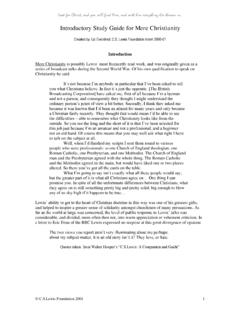Transcription of Rethinking the psychology of tyranny ... - BBC Prison Study
1 Copyright The british Psychological Society Reproduction in any form (including the internet) is prohibited without prior permission from the Society 1. The british Psychological british Journal of Social psychology (2006), 45, 1 40. q 2006 The british Psychological Society Society Rethinking the psychology of tyranny : The BBC Prison Study Stephen Reicher1* and S. Alexander Haslam2**. 1. University of St. Andrews 2. University of Exeter This paper presents findings from the british broadcasting corporation (BBC) Prison Study an experimental case Study that examined the consequences of randomly dividing men into groups of prisoners and guards within a specially constructed institution over a period of 8 days. Unlike the prisoners, the guards failed to identify with their role.
2 This made the guards reluctant to impose their authority and they were eventually overcome by the prisoners. Participants then established an egalitarian social system. When this proved unsustainable, moves to impose a tyrannical regime met with weakening resistance. Empirical and theoretical analysis addresses the conditions under which people identify with the groups to which they are assigned and the social, organizational, and clinical consequences of either doing so or failing to do so. On the basis of these findings, a new framework for understanding tyranny is outlined. This suggests that it is powerlessness and the failure of groups that makes tyranny psychologically acceptable. In the introduction to his text on The Roots of Evil, Staub writes: the widespread hope and belief that human beings had become increasingly civilized' was shattered by the events of the Second World War, particularly the systematic, deliberate extermination of six million Jews by Hitler's Third Reich' (1989, p.)
3 3). The impact of this realization was as marked in academia, and more particularly within academic psychology , as it was in society at large. Indeed, it is arguable that the shadow of the Holocaust lies over the last half century of social psychology and, either indirectly or directly, informs many of the core issues that are of concern to the discipline's practitioners: questions such as how we come to hate and to discriminate against members of other groups (Tajfel, Flament, Billig, & Bundy, 1971), how people come to see others as less human and less deserving than themselves (Leyens et al., 2003), how the seeds of authoritarianism, social dominance, and power abuse are sown and cultivated (Adorno, Frenkel-Brunswik, Levinson, & Sanford, 1950), and the question which concerns us most directly in this * Correspondence should be addressed to Stephen Reicher, School of psychology , University of St.
4 Andrews, St. Andrews, Fife, KY16 9JU, UK (e-mail: **Correspondence should be addressed to Alex Haslam, School of psychology , University of Exeter, Exeter, Devon, EX4 4QG, UK (e-mail: Copyright The british Psychological Society Reproduction in any form (including the internet) is prohibited without prior permission from the Society 2 Stephen Reicher and S. Alexander Haslam paper how we come to condone the tyranny of others or else act tyrannically ourselves. While the literature in these various areas is both broad and varied, it is possible to identify at least one major trend. That is, there has been a shift away from explanations that focus on the individual characteristics of those who are prejudiced, discriminatory, or even genocidal, towards those that concentrate on the nature of group processes which can induce the most inoffensive of individuals to commit the most offensive of acts (Billig, 1978; Brown, 1965; Milgram, 1974; Sherif, 1966; Tajfel, 1982).))
5 In many cases, and certainly when it comes to the psychology of tyranny , theorists have taken the argument one step further and proposed not only that extreme antisocial behaviour must be analysed at the group level, but also that group psychology necessarily tends in the direction of extreme antisocial behaviour. While we strongly endorse the need for a group-level psychology of tyranny (which we define as an unequal social system involving the arbitrary or oppressive use of power by one group or its agents over another), we will take issue with the notion that groups per se are the root of the problem. Indeed, we will argue that powerful and effective groups provide an effective psychological bulwark against tyranny and that it is when groups prove ineffective that tyrannical forms of social organization begin to become attractive.
6 The equation of groups and tyranny has a long history both within social thought and within social psychology . Hannah Arendt (1998) describes the classical view that the rule by many is not good' and traces this back to Aristotle's contention that collective rule leads to haphazardness, moral irresponsibility, and is but a disguised form of tyranny . More recently, such ideas were given substance by crowd psychologists such as Gustave LeBon (1895/1947) who argued that, through submergence in the crowd, individuals lose their individual identity and their sense of responsibility and hence become capable of barbaric and atavistic acts. The notion of submergence was directly transposed into the modern social psychological concept of de-individuation, which is seen to arise from anonymity within a group (Postmes & Spears, 1998; Reicher, Spears, & Postmes, 1995).
7 As one influential de-individuation researcher has put it, mythically, deindividuation is the ageless life force, the cycle of nature, the blood ties, the tribe, the female principle, the irrational, the impulsive, the anonymous chorus, the vengeful furies.' (Zimbardo, 1969, p. 249). tyranny as role and power Though well known as a de-individuation theorist, Zimbardo is better known for his work on the Stanford Prison experiment (SPE; Haney, Banks, & Zimbardo, 1973;. Zimbardo, 1989; Zimbardo, Maslach, & Haney, 1999). Indeed, this is one of the most famous social psychological investigations ever conducted, representing the culmina- tion of a series of classic' field studies into the roots of extreme behaviours that were conducted in the aftermath of World War Two (Milgram, 1963; Sherif, 1956).
8 Building on earlier studies, it played a critical part in cementing the shift that we have described from individual to group-level explanations of extreme behaviours (Banuazizi &. Movahedi, 1975). Moreover, it was one of the few studies that not only addressed the issue of tyranny but, due to the power of the research paradigm, also produced direct evidence of tyrannical behaviour. While it is not, strictly speaking, a Study of de-individuation, Zimbardo certainly used his general understanding of the group as a corrosive force to explain events in the SPE. Copyright The british Psychological Society Reproduction in any form (including the internet) is prohibited without prior permission from the Society The psychology of tyranny 3. The SPE is remembered for showing that, simply as a consequence of assigning college students the role of guard or prisoner, the former became increasingly brutal while the latter became passive and began to show signs of psychological disturbance.
9 Such was the severity of these phenomena that the Study , originally scheduled to last 2. weeks, had to be stopped after 6 days. Zimbardo and colleagues explained their findings by commenting that guard aggression was emitted simply as a natural' consequence of being in the uniform of a guard' and asserting the power inherent in that role' (Haney et al., 1973, p. 12). Thus, immersion in a group is seen to undermine the constraints that normally operate upon people when they act as individuals. In addition, when those groups have power at their disposal, this is believed to encourage extreme antisocial behaviour (Zimbardo, 1969). Although these findings were significant in their own right, the impact of the SPE. was as much ethical as theoretical ( see Smith & Mackie, 2000, p.)
10 49). Indeed, the very extremity of the results led many (including Zimbardo himself) to question the legitimacy of subjecting participants to such situations. The acceptability of conducting any sort of large-scale field interventions thus became a focus for vigorous debate ( Herrera, 1997; Lindsay & Adair, 1990; Sieber, Iannuzzo, & Rodriguez, 1995; Smith &. Richardson, 1983). Paradoxically, then, at the same time that the SPE marked the culmination of post-war field studies, it also led to their cessation. Accordingly, since the 1970s, social psychology has been increasingly dominated by laboratory experiments in which there is minimal or no interaction between participants and scant attention paid to the role of personal and group history or to the development of interactions over time (Bar Tal, 2004; Doosje, Spears, & Ellemers, 2002; Haslam & McGarty, 2001; Levine, 2003; Moreland, Argote, & Krishnan, 1996).








